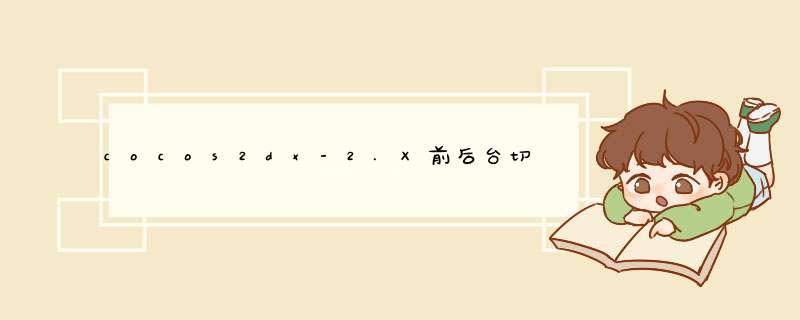
摘自网上的androID生命周期图:
cocos2dx-2.X前后台切换分析,基于androID平台:1、从后台进入前台项目的activity一般继承自Cocos2dxActivity,看过activity生命周期的都知道onCreate,onResume等方法,这些函数是activity生命周期中最重要的函数,具体什么时候调用,可以查看相关资料。 //刚进入游戏和游戏从后台回到前台会调用 @OverrIDe protected voID onResume() { super.onResume(); Log.d(TAG,"onResume+++++++++++++++++++++++"); Cocos2dxHelper.onResume(); this.mGLSurfaceVIEw.onResume(); --->> } this.mGLSurfaceVIEw.onResume(); 方法--->> @OverrIDe public voID onResume() { super.onResume(); this.setRenderMode(RENDERMODE_CONTINUOUSLY); //使用queueEvent方法:主要是从UI线程切换到OpenGL渲染线程 this.queueEvent(new Runnable() { @OverrIDe public voID run() { Cocos2dxGLSurfaceVIEw.this.mCocos2dxRenderer.handleOnResume(); } }); } ------>>> public voID handleOnResume() { //private static native voID nativeOnResume(); //调用了一个native方法,在C++端实现 Cocos2dxRenderer.nativeOnResume(); } //C++端的实现在Java_org_cocos2dx_lib_Cocos2dxRenderer.cpp文件中: JNIEXPORT voID JNICALL Java_org_cocos2dx_lib_Cocos2dxRenderer_nativeOnResume() { //做个标记(1)这里和我要在下面说的一点有关**** if (CCDirector::sharedDirector()->getopenGLVIEw()) { CCApplication::sharedApplication()->applicationWillEnterForeground(); } } // this function will be called when the app is active again //进入前台,我们可以在这里做一些处理 voID AppDelegate::applicationWillEnterForeground() { CCDirector::sharedDirector()->startAnimation(); SimpleAudioEngine::sharedEngine()->resumeBackgroundMusic(); } 2、 //从前台进入后台会调用过程 @OverrIDe protected voID onPause() { super.onPause(); Log.d(TAG,"onPause+++++++++++++++++++++++"); Cocos2dxHelper.onPause(); this.mGLSurfaceVIEw.onPause(); } //this.mGLSurfaceVIEw.onPause();--->> @OverrIDe public voID onPause() { this.queueEvent(new Runnable() { @OverrIDe public voID run() { Cocos2dxGLSurfaceVIEw.this.mCocos2dxRenderer.handleOnPause(); } }); this.setRenderMode(RENDERMODE_WHEN_DIRTY); //super.onPause(); } ---->>>mCocos2dxRenderer.handleOnPause: public voID handleOnPause() { Cocos2dxRenderer.nativeOnPause(); } ----->>>native方法,调用C++端的函数: private static native voID nativeOnPause(); //C++端的实现在Java_org_cocos2dx_lib_Cocos2dxRenderer.cpp文件中: JNIEXPORT voID JNICALL Java_org_cocos2dx_lib_Cocos2dxRenderer_nativeOnPause() { //进入后台 CCApplication::sharedApplication()->applicationDIDEnterBackground(); CCNotificationCenter::sharednotificationCenter()->postNotification(EVENT_COME_TO_BACKGROUND,NulL); } // This function will be called when the app is inactive. When comes a phone call,it's be invoked too //进入后台,我们可以在这里做一些处理。 voID AppDelegate::applicationDIDEnterBackground() { CCDirector::sharedDirector()->stopAnimation(); SimpleAudioEngine::sharedEngine()->pauseBackgroundMusic(); }3、我的一点疑惑(已解决)从activity生命周期中我们看到,在第一次进入游戏中时也会调用onResume方法,如果这样,那我们就不能认为调用applicationWillEnterForeground方法的时机是从后台进入前台,如果这样我们在处理游戏从后台进入前台时,就需要注意这个问题。其实,第一次进入游戏applicationWillEnterForeground方法是不会调用的,我们可以不用管上面我说的那个问题。至于为什么,下面分析:3.1、在activity中的onResume方法和Cocos2dxRenderer类中的onSurfaceCreated方法中加入log日志,看下两个地方的执行顺序: @OverrIDe //onSurfaceCreated在surface创建时调用,在这里调用nativeInit方法进行一些初始化。 //具体整个过程,可以查看cocos2dx启动过程相关的资料。 public voID onSurfaceCreated(final GL10 pGL10,final EGLConfig pEGLConfig) { Log.d("","onSurfaceCreated+++++++++++"); Cocos2dxRenderer.nativeInit(this.mScreenWIDth,this.mScreenHeight); this.mLastTickInNanoSeconds = System.nanoTime(); } --->>> voID Java_org_cocos2dx_lib_Cocos2dxRenderer_nativeInit(jnienv* env,jobject thiz,jint w,jint h) { if (!CCDirector::sharedDirector()->getopenGLVIEw()) { //这里创建才创建CCEGLVIEw,第二个标记(2)***** CCEGLVIEw *vIEw = CCEGLVIEw::sharedOpenGLVIEw(); vIEw->setFrameSize(w,h); AppDelegate *pAppDelegate = new AppDelegate(); CCApplication::sharedApplication()->run(); } else { //其实这里我有一点疑问?就是这个分支什么时候会被执行,我试了很多次,都没有看到什么时候执行。 //有待以后学习。 ccGlinvalIDateStateCache(); CCshadercache::sharedshadercache()->reloadDefaultShaders(); ccDrawInit(); CCTextureCache::reloadAllTextures(); CCNotificationCenter::sharednotificationCenter()->postNotification(EVENT_COME_TO_FOREGROUND,NulL); CCDirector::sharedDirector()->setGLDefaultValues(); } } activity中的onResume方法和Cocos2dxRenderer类中的onSurfaceCreated方法的执行顺序:看下面的输出信息就可以清楚的知道,onResume方法先执行而onSurfaceCreated方法后执行。05-21 16:03:32.520: D/Cocos2dxActivity(7953): onResume+++++++++++++++++++++++ 05-21 16:03:32.740: D/(7953): onSurfaceCreated+++++++++++还记的我们做过的(1)和(2)两个标记吗?标记(1):看到这里大家应该明白了吧,这里对是否进入applicationWillEnterForeground函数加了一个判断CCDirector::sharedDirector()->getopenGLVIEw()即CCEGLVIEw是否存在,按照上面的说明在 onSurfaceCreated -->> Java_org_cocos2dx_lib_Cocos2dxRenderer_nativeInit -->>--->> CCEGLVIEw *vIEw = CCEGLVIEw::sharedOpenGLVIEw() 即在nativeInit方法中才创建CCEGLVIEw类的实例,根据上面说的执行顺序,onResume方法在onSurfaceCreated方法之前执行,就意味着在nativeInit方法之前执行,同样意味着第一次进入游戏时,因为CCDirector::sharedDirector()->getopenGLVIEw()方法返回NulL,因为还没有实例化,所以applicationWillEnterForeground方法并不会执行。而当游戏从后台切换到前台时,CCDirector::sharedDirector()->getopenGLVIEw()方法返回已经构造的实例变量,所以可以进入applicationWillEnterForeground函数。JNIEXPORT voID JNICALL Java_org_cocos2dx_lib_Cocos2dxRenderer_nativeOnResume() { //做个标记(1)这里和我要在下面说的一点有关**** if (CCDirector::sharedDirector()->getopenGLVIEw()) { CCApplication::sharedApplication()->applicationWillEnterForeground(); } } 总结 以上是内存溢出为你收集整理的cocos2dx-2.X前后台切换分析,基于android平台全部内容,希望文章能够帮你解决cocos2dx-2.X前后台切换分析,基于android平台所遇到的程序开发问题。
如果觉得内存溢出网站内容还不错,欢迎将内存溢出网站推荐给程序员好友。
欢迎分享,转载请注明来源:内存溢出

 微信扫一扫
微信扫一扫
 支付宝扫一扫
支付宝扫一扫
评论列表(0条)